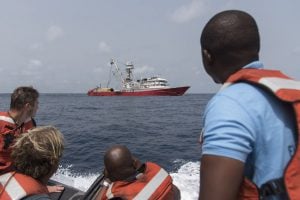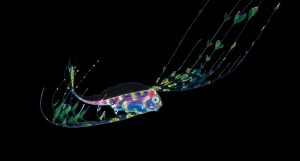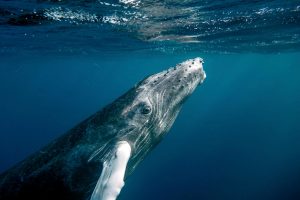After two years of delays, March saw the completion of a fourth round of talks on a treaty to conserve and sustainably use biodiversity in the high seas. The negotiations, held under the UN Convention on the Law of the Sea (UNCLOS), fell short of producing a final treaty, but participants were optimistic and said substantive progress had been made.
The aim of the talks is to produce as single treaty that covers four components as a package: access to and sharing of the benefits of marine genetic resources; area-based management tools, including marine protected areas (MPAs); environmental impact assessments; and capacity building and technology transfer from richer to poorer nations.
For conservation groups, the talks on area-based management tools are of particular interest. Talks on setting up MPAs face a key legal issue: any one area of the high seas could fall under the jurisdiction of international bodies focussed on different industries: various regional fisheries management organisations, the International Seabed Authority, the International Maritime Organisation, and so on. All of these have their own area-based management tools, as mandated by their respective treaties, but none has the legal basis to set up MPAs for general conservation aims. The high seas treaty being negotiated is expected to provide that basis.
Currently, it looks as if the emerging treaty would set up a Conference of the Parties (COP), which would enable negotiations for designating MPAs. If the COP makes decisions that need to be implemented by other international organisations, it could be viewed as a superior body. Such a possibility worries many countries, and very early on a principle was established: any new treaty, regime or instrument should not “undermine” existing bodies and legal instruments. In the March talks, there was opposition to language about “complementarity” between new and old bodies. In other words, turning the COP into a higher-ranking international organisation is not an option – any new body should be of equal standing to those already in existence, and not manage matters already regulated by them.
But how to define “undermining”? Is it possible to complement existing systems without undermining them? To answer these questions, we first need to understand how international bodies are independent of each other, and the origin of this compartmentalisation in domestic arrangements.
Independence between international systems
National sovereignty means there is no supranational government: the validity of international environmental law is rooted in national consent. In other words, rules are ineffective without agreement. When an international treaty is signed, an international body composed of the signatories may be set up to implement it. Even if such a body is not created, there will often be some kind of system in place for joint decision-making and compliance, such as a COP. Usually, nations are represented by the appropriate national counterpart (foreign affairs authorities are also involved, but work relies primarily on the specialist abilities of the national counterpart). Their agreement represents the agreement of their nation. So, when votes are held in multilateral systems it is much easier if the matters being decided correspond to those within the jurisdiction of the national counterpart. The process is much more complicated when consultations are required with other national bodies back home.
As an example, in 2014 the annual meeting of the Commission for the Conservation of Antarctic Marine Living Resources (CCAMLR) discussed one of the IMO’s rules for shipping in the Antarctic, which bans the use or carrying of heavy fuel oil. CCAMLR wanted the ban to also cover the use of heavy fuel oil as ballast. This caused problems: the national competent authority in attendance were fishery authorities, while shipping rules fall under the jurisdiction of transportation authorities, and it was hard for those present to consult in time.
In domestic politics, boundaries are clear, and coordinating across authorities responsible for different sectors is hard. Only important issues get the necessary high-level coordination. For example, China has set up a National Leading Group on Climate Change under the State Council, chaired by the premier. For the specialised national authorities, avoiding conflict among themselves is crucial for the smooth operation of their work. This is simply the outcome of how national governments divvy up work. It means international bodies do their best to avoid issues which will require cross-departmental consultations when setting agendas, and hope that countries submitting proposals will first do the necessary domestic coordination, and have the appropriate national counterpart raise the issue in the appropriate international forum.
However, clear boundaries and jurisdictions can mean nobody looks at the bigger picture. A lack of coordination on ocean policy could lead to governance failures and ecosystem collapse. One of the features of MPAs is their conservation targets which are set according to the nature of the ecosystem and human needs. Then, those targets should decide how the MPA should be managed.
The OSPAR protected area: conservation goals driving cross-sectoral management
A good example of how conservation goals can drive cross-sectoral management is the OSPAR convention. More properly known as the Convention for the Protection of the Marine Environment of the North-East Atlantic (known as OSPAR as it combined earlier treaties concluded in Oslo and Paris), OSPAR tackles threats to the marine environment such as land-source pollution, pollution from coastal infrastructure and dumping. It has established several MPAs on the high seas. However, OSPAR’s initial mandate only covered the prevention of pollution, not fishing policy, and in order to establish its first batch of MPAs it had to pass its Annex V, bringing all human activity within its remit.
To ensure cross-sectoral protections, OSPAR had to coordinate with other international organisations. However, OSPAR chose to first create the MPAs and set overall conservation goals before approaching other bodies. Language on the goals and targets of the MPAs featured prominently in OSPAR documents, including decisions taken by the COP and proposals on MPA management.
OSPAR’s recommendations for how the MPAs should be managed (such as quota systems for fishing) are not legally binding, but encourage member states to engage “with third parties and relevant international organisations, as appropriate, with a view to promoting the delivery of the conservation objectives that the OSPAR Commission has set.” In 2011, the commission signed a memorandum of understanding with the International Seabed Authority, and in 2014 a “collective arrangement” with the North-East Atlantic Fisheries Commission (NEAFC). That second agreement saw NEAFC designate part of OSPAR’s MPAs as “Vulnerable Marine Ecosystems”, where fishing is banned. Those agreements complement management of the MPAs and bring more stakeholders on board. Countries which have not signed up to OSPAR become bound by the rules of other organisations they are a part of, but also become able to influence OSPAR via participation in those organisations. And the cooperation between OSPAR and other bodies indicates that they acknowledge the value of setting up the MPAs.
Legal backing and coordinating action
Talks on Antarctic MPAs were once hampered by concerns over legal status. Some countries held that CCAMLR was only a regional fishery management organisation, while MPAs were a comprehensive conservation tool, so CCAMLR had no legal powers to create them. Setting up MPAs in other parts of the high seas will run into the same problem. This is why the new treaty on the high seas will provide the necessary legal basis. And any such treaty would not just be passively quoted – OSPAR’s experience shows that it could actively help coordination during negotiations.
The International Union for Conservation of Nature has stressed the importance of conservation goals in categorising MPAs, saying that conservation and the protection of biodiversity must be the primary goal of an MPA. If talks under the high seas treaty can come up with scientifically sound conservation or management goals for various areas, which are acceptable to all parties, that will at the least encourage and guide the work of other international organisations. Those sector-specific organisations only represent countries with substantive current interests in a certain ocean area, while a high seas treaty would represent the interests of all humanity, better reflecting their importance as part of the public domain.
Passing a high seas treaty would result in many countries needing to change how they manage ocean areas. That cross-sectoral perspective on ocean management was one of the “transformative changes” referred to in the IPBES 2019 Global Assessment Report – the most important scientific assessment by an intergovernmental body on the state of nature in almost 15 years.








